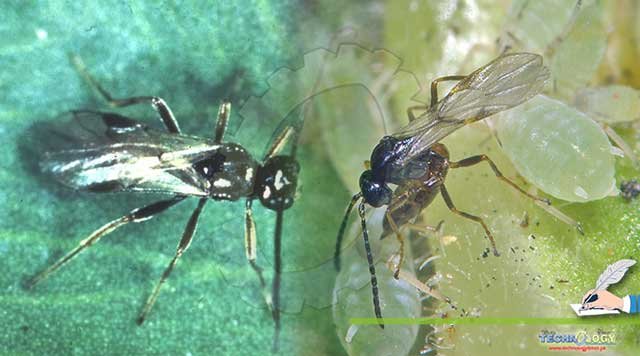Environmental adaptability and physiological relationship with the host organism is one of the descriptive feature insect parastoids.

By Danyal Haider Khan, Muhammad Zaryab Khan, Muhammad Ashir, Raees Saleem
Alteration in the Physiology of Host
There has been significant potential of interaction with host in many true parasites and they assist them in many of their physiological processes and only kill them when the development stage of wasp is completed. First of all, the immune system reacts against the egg and juvenile stages of pararstoids which is the foremost threat these creature have to avoid. Furthermore these parastoids have to alter the chemical and metabolic processes of the host organism to make favorable environment for its reproductive succession. The most unique and highly developed mechanism of altering host metabolic and physiological processes is found in the parasites of order Hymenoptera, in which the combination of regulation factors not only of embryonic origin but also of maternal origin. An obligate symbiotic virus that has a very specific life cycle and belongs to the family of Poldnaviridae is found in association with the larvae of endophagous lepidopteran parastoids and it is linked directly to the lives of both host and parastoids.
Genome of wasp contain all types of viruses into their constitution as proviruses that they pass through germline, Double stranded circular DNA molecules of viral particles are produced in the female ovary. In the host, PDV gene expression is responsible for several pathological symptoms observed in parasitized individuals, such as suppression of the immune system and disruption of the endocrine balance. These alterations of host physiology and development are of fundamental importance to the parasitoid progeny, which, in their absence, would be killed by host blood cells (haemocytes) and would not find the appropriate biochemical milieu required for growth and development. A endophagous parasitoid of the tobacco budworm carries a polydnavirus (TnBV), actively replicating in the wasp’s ovary.
Nutrient acquisition and Allocation from host :
Nutrient acquisition and allocation strategies of parasitoids are strongly linked to two components of life-history: (i) egg production and (ii) mode of parasitism. For the former, parasitoids can be divided into pro-ovigenic species that emerge as adults with a fixed complement of mature eggs and synovigenic species that continue to mature eggs during the adult stage. Pro-ovigenic parasitoids allocate nutrient reserves during the adult stage to maintenance, while synovigenic parasitoids confront the decision of whether to allocate reserves to egg production, maintenance, or both. Parasitoids actually exhibit a continuum of ovigeny that can be indexed. Relatively few species are strictly pro-ovigenic and synovigeny ranges from species that emerge with most eggs mature to species that emerge with no mature eggs while in another study parasitoids were divided into idiobionts, whose hosts cease development after parasitism and koinobionts, whose hosts remain mobile and continue to grow. All idiobionts are either ectoparasitoids that paralyze their hosts or endoparasitoids that parasitize sessile host stages like eggs or pupae. Most koinobionts in contrast are endoparasitoids that parasitize insect larvae. Egg production and mode of parasitism strategies are also interrelated. Parasitoids that exhibit extreme synovigeny, for example, are all idiobionts that produce yolk-rich (anhydropic) eggs and low ovigenic indices, whereas koinobionts tend to produce yolkdeficient (hydropic) eggs and have high ovigenic indices. Since idiobionts parasitize hosts of static size, selection favors oviposition on larger, late-stage hosts, which suffer lower mortality rates and thus select for larger egg sizes and concomitantly lower fecundities . Most idiobionts are also ectoparasitoids whose eggs require a pre-packaged yolk source for development. Reciprocally, the ability of koinobionts to attack hosts of variable size favors parasitism of early stage larval hosts that suffer higher mortality rates and thus, favor smaller eggs and larger fecundities. The production of smaller, yolk-deficient eggs is also probably favored in koinobionts by: (i) endoparasitism and access to host nutrients for embryonic development; and (ii) the inability of koinobionts to feed on the mobile, often aggressive, hosts they attack.
Role of viral Particals in Parasitism:
When T. nigricepsoviposits, it injects into the host body the egg along with TnBV particles, which contain the segmented viral genome. The parasitoid embryo is surrounded by a serosal membrane that, at hatching, dissociates into single rounded cells, the teratocytes . These cells freely float in the host haemocoel, and, as the parasitoid larva develops, they increase in size and ploidy level, without undergoing division. TnBV and teratocytes are the two major host regulation factors, respectively of maternal and embryonic origin, responsible for the physiological alterations induced by parasitization. The functional and molecular bases of host disguise, mediated by T. nigriceps parasitism, are currently being investigated in our laboratories. The disruption mechanism of host hormonal balance has been further studied, and TnBV genes, expressed in parasitized hosts, are being cloned and characterized. In the present paper, a brief overview of the available information on this host-parasitoid system and of the research work under current development is provided. Host endocrine alterations An individual H. virescens last instar larva, parasitized by T. nigriceps, shows a developmental arrest in response to a severe alteration of hormonal balance and is completely consumed by the parasitoid mature larva, which emerges from the host to spin a cocoon.
Affects on Molting:
In contrast, juvenile hormone (JH) biosynthesis in vitro by corpora allata explanted from host early last (5th) instar larvae, is slightly affected by T. nigriceps parasitism, as is JH metabolism. However, the resulting higher JH titre in early 5th instar larvae parasitized by T. nigriceps, before pupal commitment, may contribute to their developmental arrest. TnBV gene cloning and characterization TnBV is a typical polydnavirus, showing a segmented genome, made of circular dsDNA molecules, which range in size from 2.5 kb to >32 kb. A functional genomic analysis of this peculiar virus has been undertaken, aiming at identifying the genes expressed in the host and their role in the regulation of parasitoid-induced pathologies.
Authors: Danyal Haider Khan, Muhammad Zaryab Khan, Muhammad Ashir, Raees Saleem